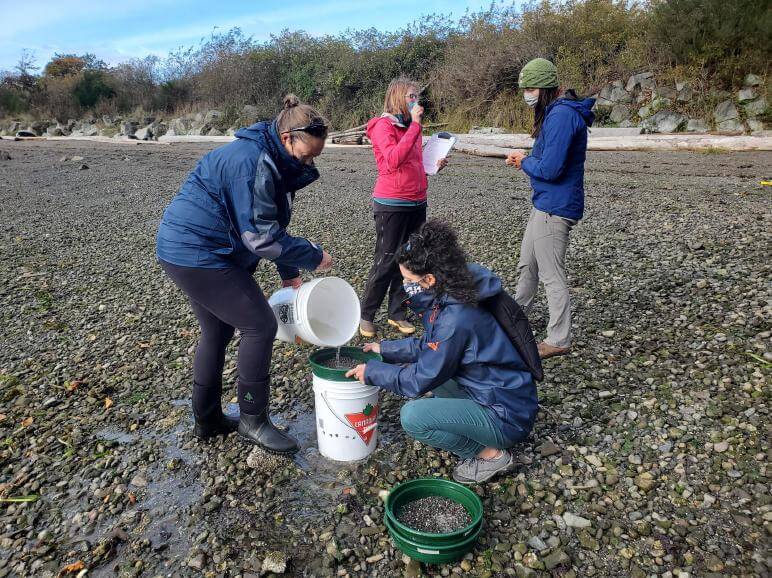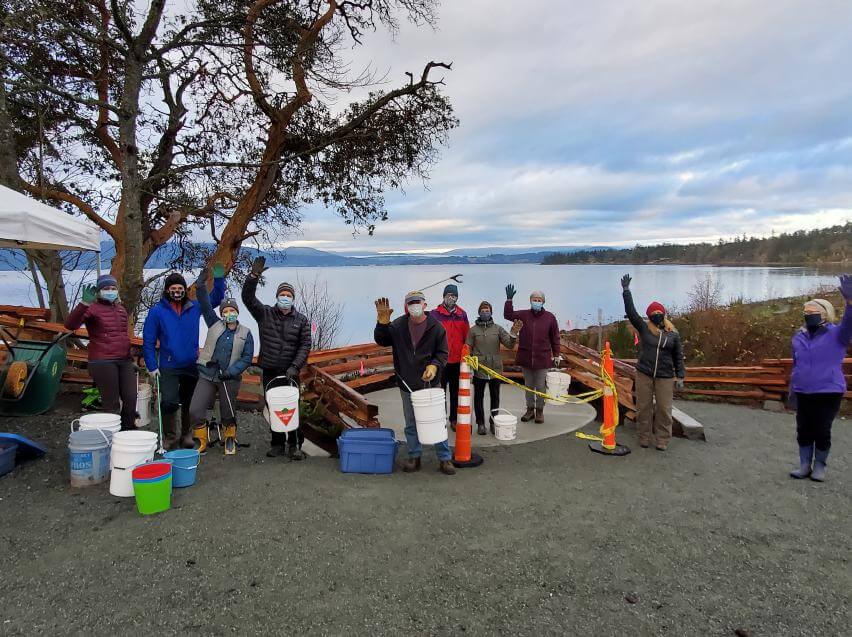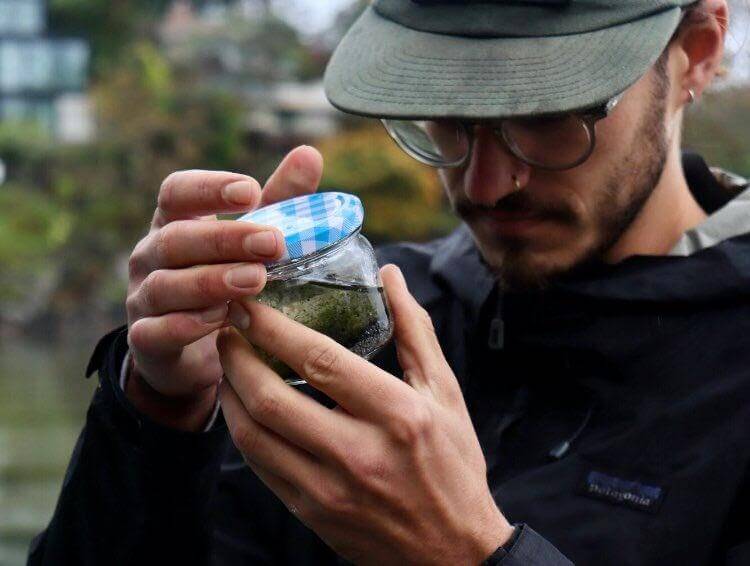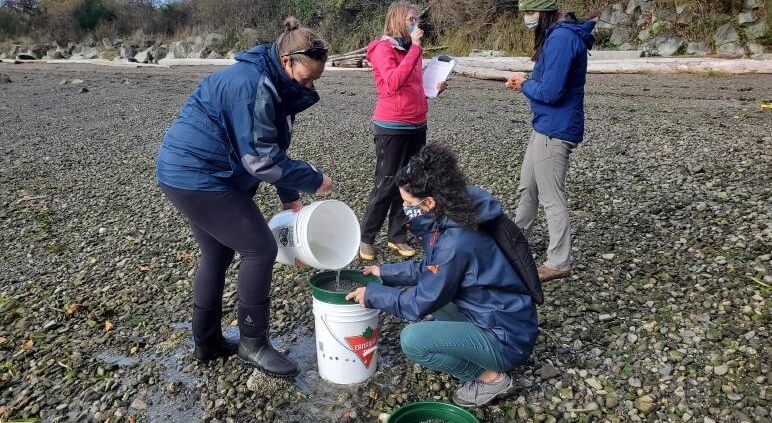Hundreds of volunteers restore salmon habitat in Greater Victoria
Habitat restoration partner Peninsula Streams Society celebrates 20 years and thousands of volunteers since its inception.
As April 16 – 22 marks National Volunteer Week in Canada, Pacific Salmon Foundation shines the light on Peninsula Streams Society (PSS), a long-term partner that relies on volunteers for its success.
Founded in 2002, the society restores and protects aquatic ecosystems and watersheds throughout Greater Victoria. The society depends on more than 175 active volunteers and 400 members to conserve and rehabilitate healthy aquatic habitats.
Guided by a 16-member board and led by a staff of paid professionals, the society provides affiliated stewardship groups with technical expertise, training, and other resources to help volunteers restore and protect habitat.
“Volunteer members of these groups are the heart and soul of the society, donating thousands of hours each year to restoration and enhancement projects,” says Ian Bruce, Peninsula Streams Society executive coordinator.
Since 2008, the Pacific Salmon Foundation’s Community Salmon Program (CSP) has provided grants to support Peninsula Streams Society volunteers. Grant funds are generated by proceeds of the federal government’s Salmon Conservation Stamp that anglers purchase to keep salmon caught in saltwater. The two organizations have partnered on more than 50 salmon habitat restoration projects with a total value of more than $5 million.
Projects have taken place in Langford, Saanich, Central Saanich, North Saanich, Sidney, Oak Bay, View Royal, and Victoria, and ranged from habitat rehabilitation to stewardship and community planning, to education, outreach, and citizen science training.
BEACH volunteers — thriving through Covid
The Peninsula Streams Society’s Beach Education and Conservation of Habitat (BEACH) Initiative, a recipient of CSP grant funding, exemplifies the importance of connections in salmon stewardship. Since its inception in 2018, more than 150 volunteers have spent nearly 3000 hours providing environmental education and stewardship training to citizen scientists.
“I’m particularly pleased with how the BEACH team pivoted during Covid-19 to achieve —and exceed — their goals, and also provide unanticipated mental health benefits to their volunteers,” says Bruce.

BEACH demonstrated innovation and implemented strict Covid safety protocols by reducing volunteer numbers at each event while increasing the number of events. Despite restrictions, the team surveyed 45 beaches, cleaning 15 kilometres of habitat and collecting 23 eDNA samples.
“The BEACH program received overwhelming support from the volunteer stewardship community, and many expressed appreciation for being able to participate in ‘Covid-relief’ activities,” says Bruce.
Sandra Foss has been a BEACH volunteer for over six years. She organizes and works with a cadre of 10 volunteers and puts in 20 hours a week across 31 sites through the winter, taking sand samples to look for evidence of forage fish spawning in local beaches.
“During Covid, instead of a group, two of us could go out on the beach and be relatively safe,” says Foss.
“This work benefits me by getting me outdoors, away from the office, and educates me about my local environment. Volunteers receive significant mental and physical health benefits,” she notes.
“Working with PSS gives me and the other volunteers I work with the opportunity to inform the public about our work and its importance,” she says. “I am proud to be able to contribute positively to improving and mitigating the impacts of sea-level rise, stormwater runoff, shoreline alterations, and climate change.”
Long-time volunteer Bill Thomas, a director with PSS, chooses to serve with the society because, “I always learn something, whether a beach clean, invasive species removal or putting smolts in a watershed. Also, giving back and improving the environment is important and PSS makes that very easy.”
Eyes on the ecosystem
Katrina Adams, senior aquatic biologist with Peninsula Streams, oversees the freshwater restoration and water quality stewardship programming.
She notes that one of the extraordinary aspects of the society’s volunteer network is their ongoing, 24/7 monitoring.
“Our volunteers provide so many eyes on the ground. From the education they’ve received, they’re constantly on the lookout for things that may adversely affect our watersheds. Their service is immeasurable in terms of environmental protection,” she says.

Boots on the ground
With a background in ecological restoration, Kyle Armstrong was approached by Bruce in 2021 to enhance the BEACH initiative along with more shoreline restoration, education, and outreach for the society.
Armstrong was interested in the role because the restoration is driven by science, and the outcomes have immense ecological impact. Not to mention the benefit to volunteers’ learning, and their ability to spread the ecological restoration message, is tremendous.
“Our volunteers are our biggest fans and advocates,” says Armstrong.
Like Adams, Armstrong noted that the massive volunteer base is essential in monitoring the shoreline and promptly addressing issues that occur.
“Recently a ship washed ashore and 20 people showed up within hours of the callout in the rain wearing gumboots, ready to shovel gravel and help,” says Armstrong.
He also notes that volunteers are involved throughout the project cycle, and projects are often volunteer driven.
“The committed base of volunteers provides capacity and life span to a project,” he says. “We love our volunteers.”

Volunteer history and future
“The society has always had volunteers as the base of the organization,” says Bruce, who was one of the original co-founders. “Caring for and feeding our volunteers is a priority.”
He notes that some volunteers have served for 20 years. They often enlist their children and even grandchildren. The society is careful to find quality volunteer activities that simultaneously provide education.
He notes Swan Creek, an ongoing restoration project for more than a dozen years funded by 10 CSP grants.
“Everything is built by hand — the spawning platforms, boulder runs and pool-creating riffles — all by volunteers.”
A volunteer with Peninsula Streams Society for more than a decade, John Coates notes that from day one, he has enjoyed being part of a team on projects using river rock and spawning gravel to enhance the water quality and function of Swan Creek.
“Basically, transforming the silent moving water of a large ‘ditch’ into a genuine ‘babbling stream’ with riffles and pools,” says Coates.
“As a volunteer I’m rewarded with all the fresh air, pleasure of invasive vegetation removal, planting native species and sighting of seasonal coho and cutthroat activity in spawning gravels placed over the past years,” he says.
With a background in community theatre, Bruce likens the volunteer participation and feedback loop to that of the stage environment where actors feed off audience energy and synergy is developed.
“Seeing our volunteers’ faces light up, their energy build when connecting with each other, sharing their passion and commitment with neighbors to benefit their common environment is infectious; it is truly a privilege to have engendered such an experience,” says Bruce.
The society is eager to recruit volunteers to continue supporting its programs. The first annual Earth Day BEACH clean-up will be happening April 26. To participate, contact Ian Bruce at 250-888-2191.



